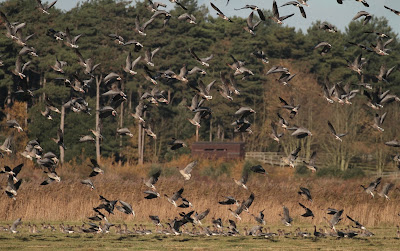Early morning at Burnham Overy marshes and distant sand dunes
Working
on the nature reserve has many rewarding days. That’s probably very much an
understatement – nearly every day has its rewards! There is nothing better than seeing
some wonder of nature whilst carrying out work on the reserve. For me, that’s
as much as the changing skies that come with the contrasting seasons. Varying
lights and weather means that even the same view can look totally different, in
fact seldom the same and very often quite dramatic. Sightings of wildlife also
seem more memorable for me when carrying out actual physical work. A glance up
at the right moment to witness a specific bird or a butterfly can be enough to
break up the day and enliven what sometimes might seem an unrewarding task.
A Great Snipe - photograph kindly supplied by Chris Knights
One
of those ‘once in a lifetime’ experiences happened in 2005 when I was ‘topping’
the marshes by tractor not far from Lady Anne’s Drive. I had just got to the
last strip of grass to cut and up popped an exceptionally rare bird from north eastern
Europe - a Great Snipe. Closer in size to a Woodcock than its smaller and more
common relative, the Snipe, this cryptically marked wader of almost mythical
desire amongst the twitching fraternity was there right in front of me, sitting
beside my front wheel! It made the memories of long days behind the wheel of a
tractor getting stuck in wet fields fade away in an instance. It is also true
to say I would never have seen it had I not been there working in a tractor. A
similar thing happened only recently, the last strip of dyke side vegetation
cut and there sat a rather regal and annoyed looking Short-eared Owl. Some
naturalists say it is bad to anthropomorphise but I defy anyone to look into
the eyes of a Short-eared Owl and not do so! This particular one really did
look like I had ruined its day by gate crashing into its own wild world.
A newly arrived migrant Short-eared Owl as seen through the window of a tractor !
Some
birds seem oblivious to the movements of tractors and the amount of exciting
species or unusual behaviour I have seen whilst working has been quite
remarkable. It is not just birds either, sometimes mammals otherwise not seen
can be observed. Species such as Short-tailed Field Voles are common and are
often seen scurrying away before a Kestrel swoops down to catch one. Birds like
Grey Herons and Kestrels seem to be in tune with our workings and soon appear
once mowing commences. The same behaviour was noted with Red Kites in the Park
recently too. One of the least seen mammals is the brightly coloured yet
diminutive Harvest Mouse. There are undoubtedly more about than we realise as normally
the only time I manage to see one is whilst topping. This year I was very lucky
to see one run off and swim across one of the dykes, its bright orange coat
looking like a lost sweet wrapper drifting across the water.
Newly arrived Pink-footed Geese preparing for a winter in Norfolk
So,
if our fields on the reserve are all grass meadows with no crops, why do we
spend so much time in tractors on the marsh? The grazing marsh meadows form
part of a very valuable and declining habitat in the UK. Lowland wet grassland
disappeared dramatically in the 20th century due to drainage schemes
and conversion to arable fields. In doing so, many of the species that formerly
thrived in them started to decline to almost disastrously low levels. At
Holkham we are fortunate in having up to 535 hectares of wetland, much of which
is wet meadowland. For it to remain attractive to our key breeding species such
as Lapwings, Redshanks and Avocets and also our wintering birds like
Pink-footed Geese and Wigeon a lot of fine tuning and effort goes into achieving
the right conditions. This involves controlling water levels, extensive grazing
by cattle, dyke dredging, providing scrapes, pools and islands and mechanical topping by tractor driven mowers. By
using mowers, areas that the cows ignore can be topped thus preventing them
turning to scrub and the correct sward height of grass can be obtained and
hopefully making them the ideal habitat for nesting Lapwings next spring.
Lapwings love to nest in short wet grassland
If
we have missed spots from our topping system all is not lost as this week alone we
have close on 10,000 newly arrived Pink-footed Geese from Iceland on our meadows, which means
quite a lot more grazing ! Typically the first few birds arrive in the first few days of September, but this year they seemed slightly later arriving but when they did appear it was in greater numbers than normal. Over 100 dropped in on 13th September and quickly increased to 1100 on 15th and over 10,000 by 21st. If you are visiting Holkham in the next few weeks take a look for the geese. In recent years we have typically seen big build ups in October before the birds disperse across the county to feed on newly harvested fields of sugar beet tops. It is still one of nature's great spectacles; masses of geese clamouring for space on the marshes, their calls reaching fever pitch amidst vast skeins often illuminated by spectacular sunsets.
Part of an early autumn mass of returning Pink-footed Geese
Andrew Bloomfield
Warden













